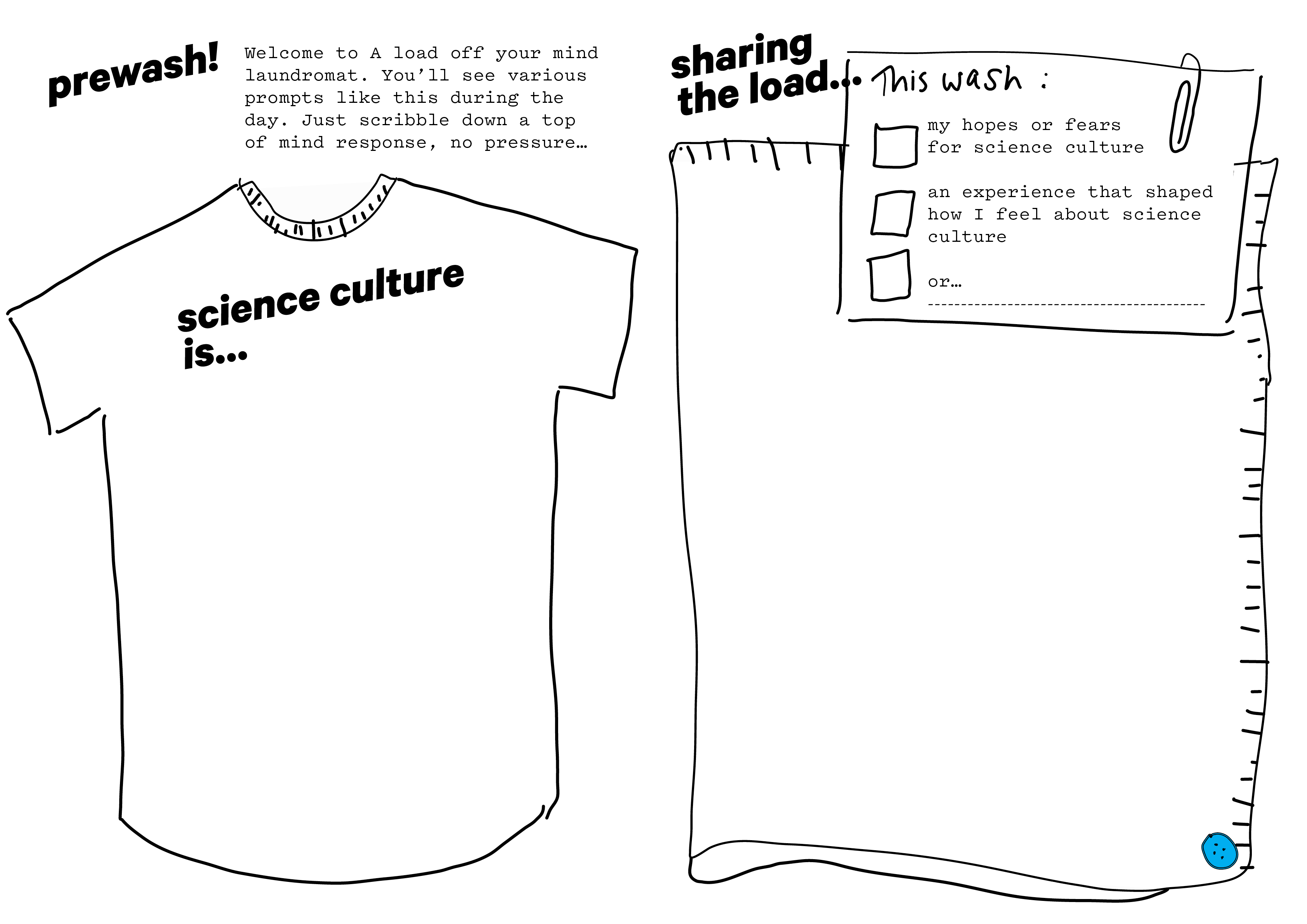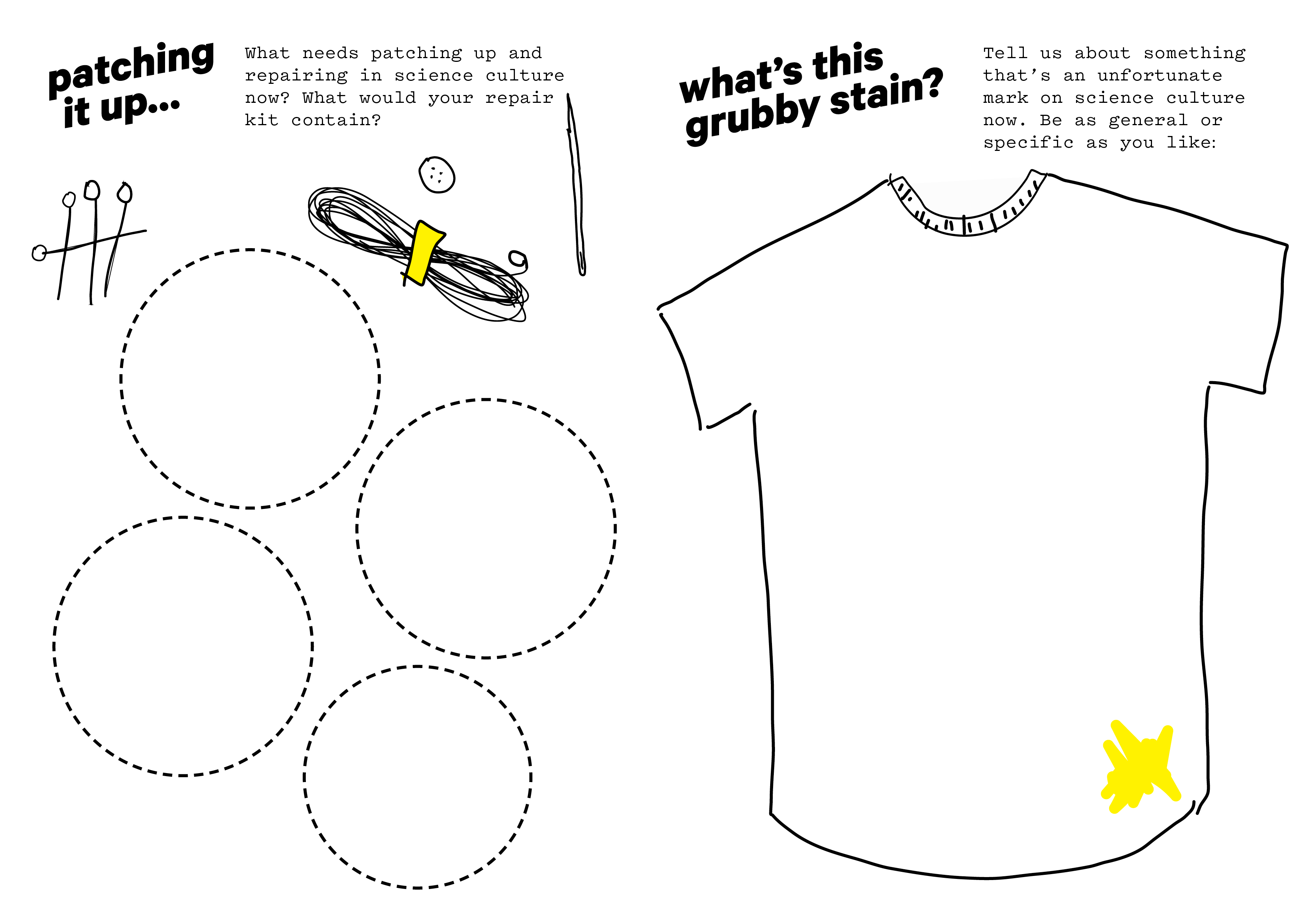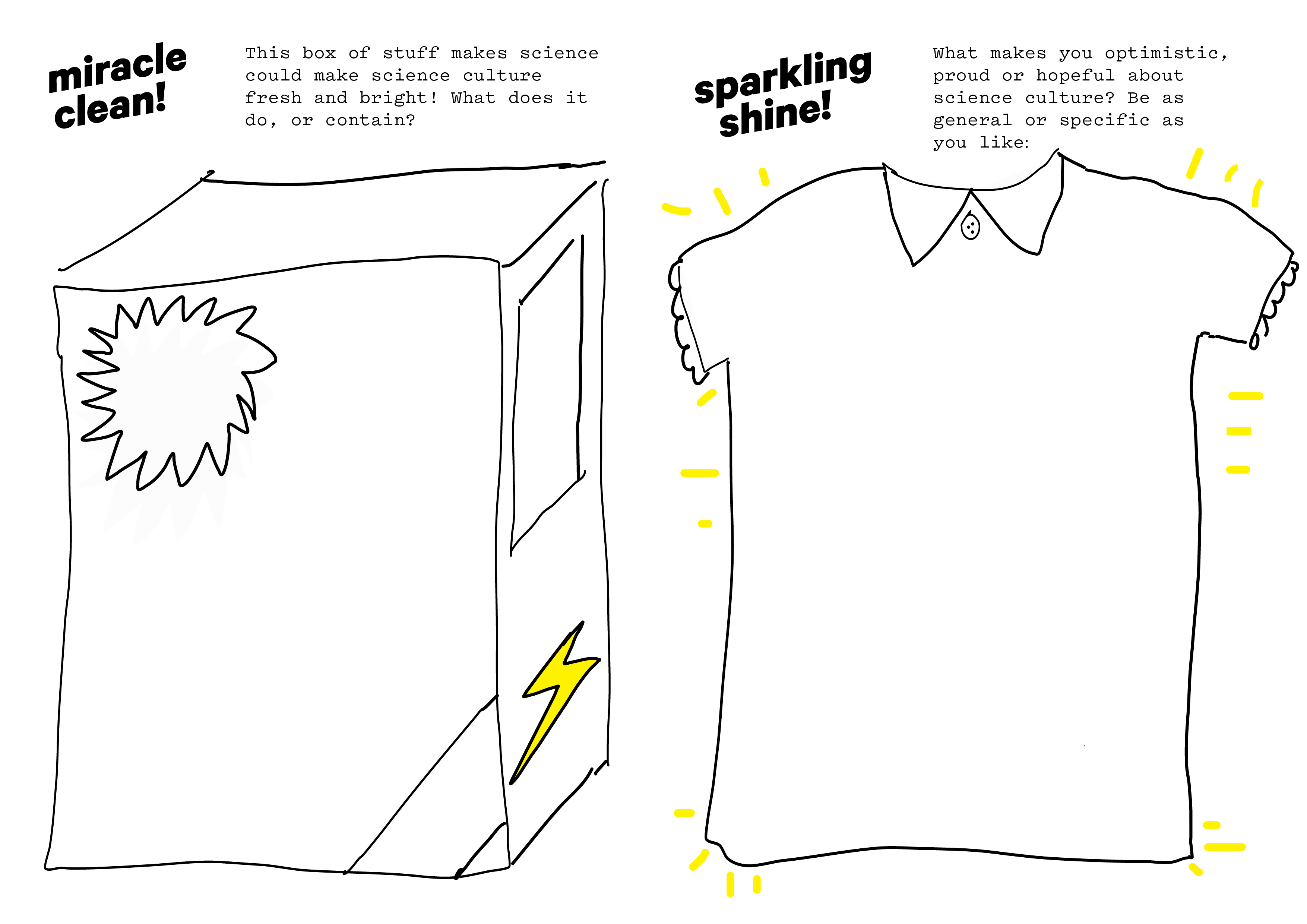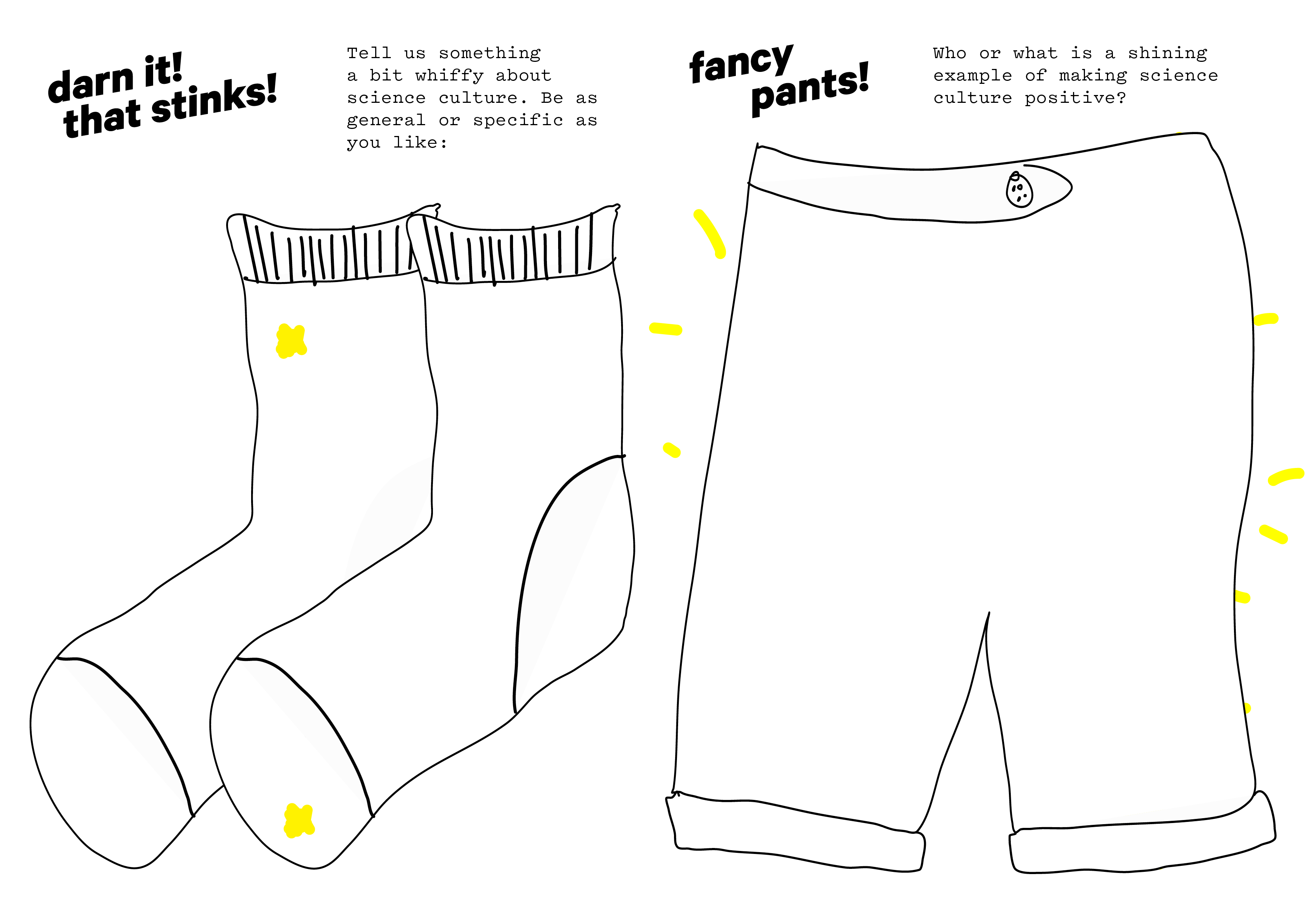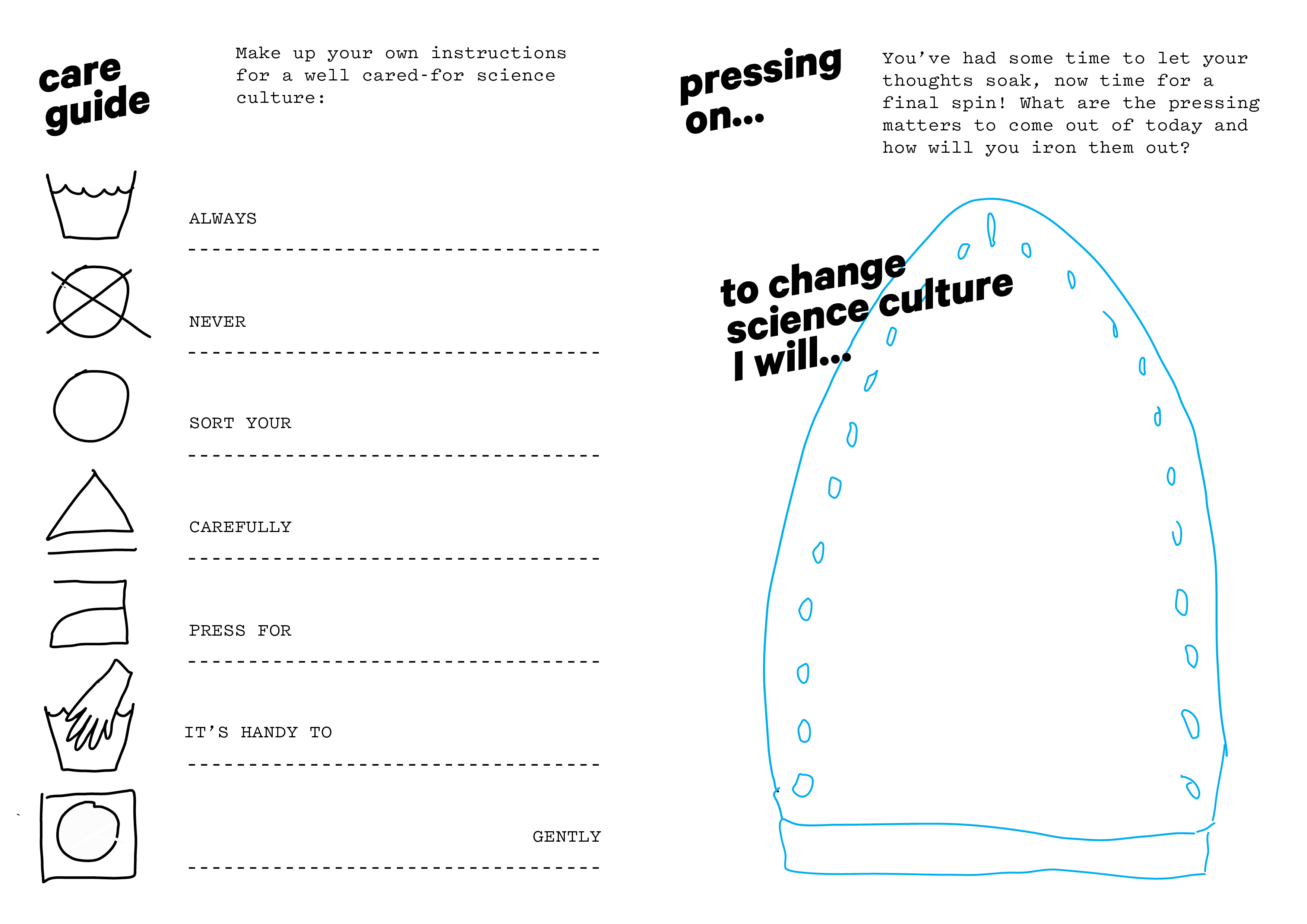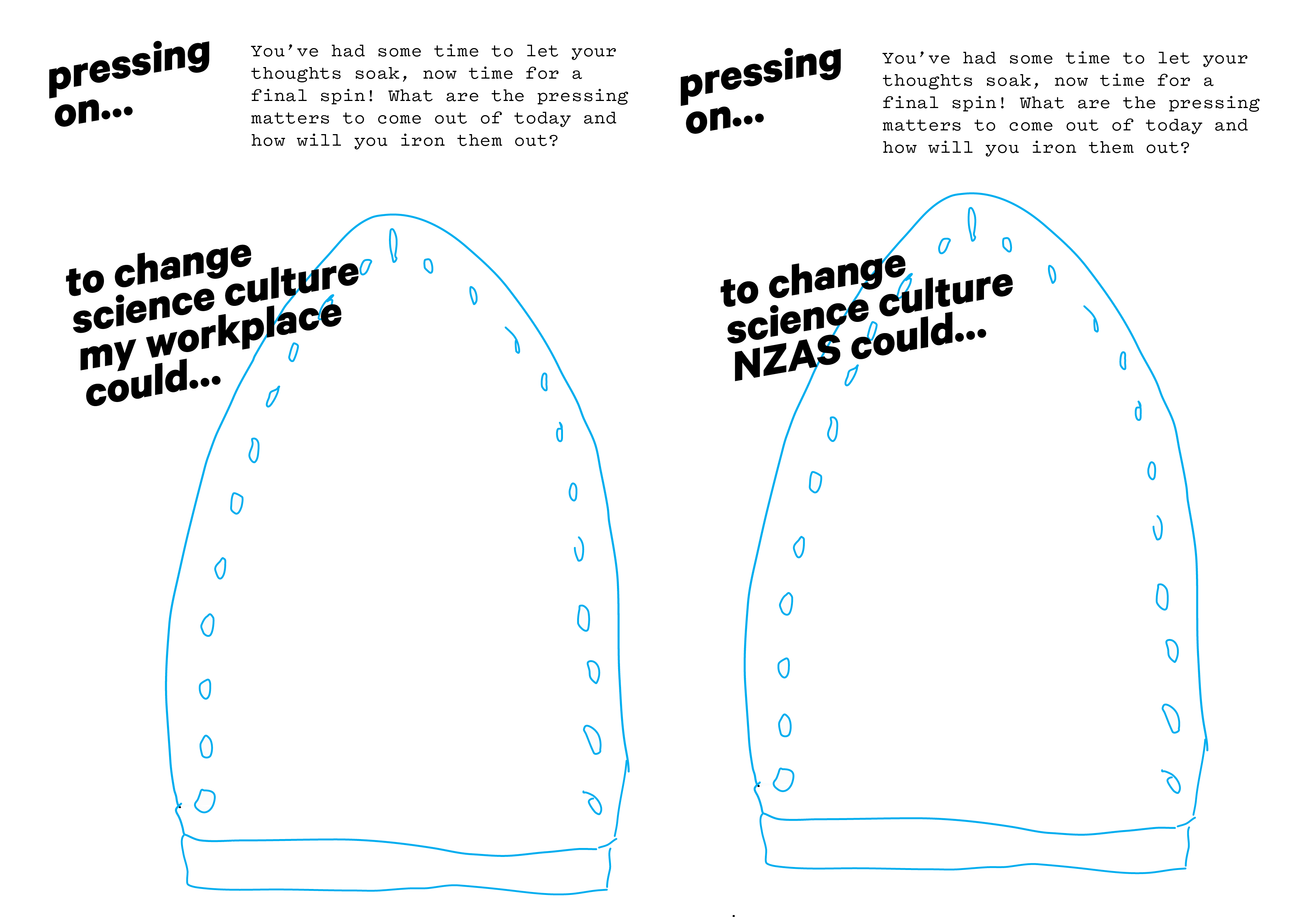PhD part 13: A load off your mind science culture laundromat: an installation for NZAS
Thanks for coming to this page about the NZAS A load off your mind science culture laundromat.
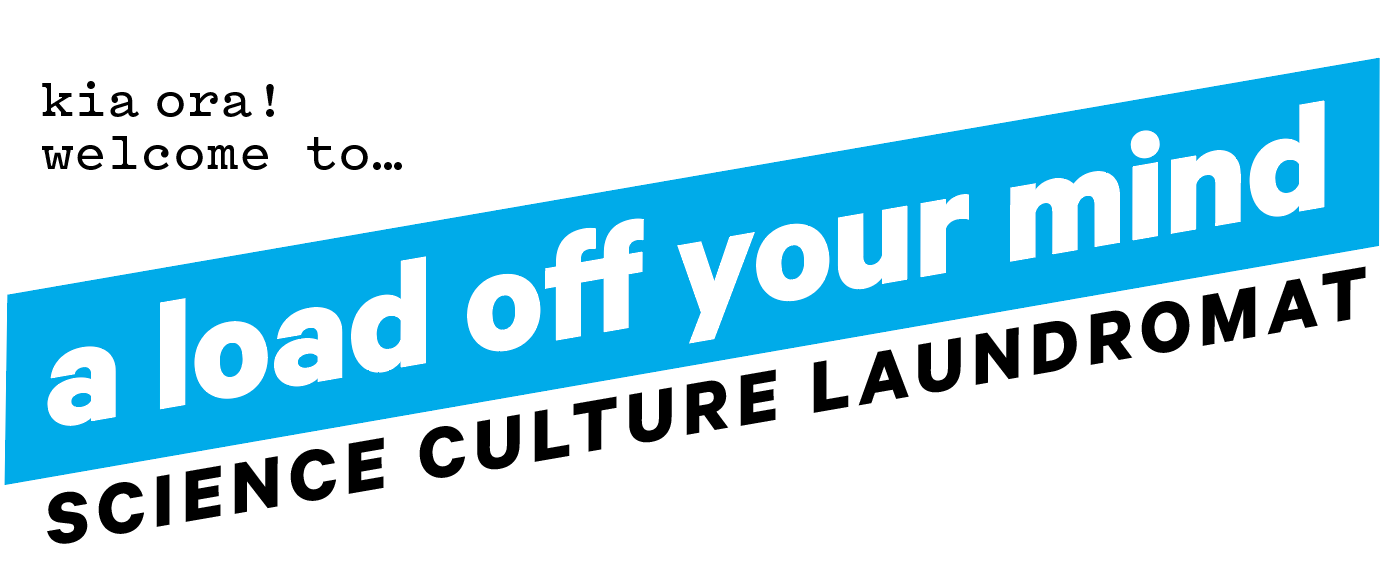
This project came about through a happy coincidence. I am researching ways of engendering reflexivity in scientists who undertake science communication activities with an intention of improving the quality of engagement.
Kate Hannah, who is curating the NZAS 2019 conference asked for suggestions for ‘fun ways’ to engage people with some of the content from this year’s conference, which has a theme of ‘Changing the Culture of Science’ and is aiming to be a space for constructive discussions around the culture of science in Aotearoa. As my research uses design approaches as a way to come at these issues, it made sense to design an experience for NZAS.
So the laundromat came about as an installation/talking point that will exist in the conference venue as a light, playful way to elicit thoughts about the way people experience science culture now (positive and negative), stories that illustrate this, and also ambitions for the future. In essence, the laundromat is a place to ‘air’ thoughts about scientific culture: what it is, what it could or should be, and experiences that have impacted it. This will be captured and documented for NZAS, and I will use it as an ‘experiment’ (in a non-scientific sense) to test some ideas about design prompts to aid reflexivity.
What is science culture in this context?
Raymond Williams, the British cultural critic, famously asserted that ‘culture is one of the two or three most complicated words in the English language’ (Williams, 1976, p.87). Williams challenged the common notion that culture means things like the ‘high arts’ – theatre, literature, painting – a realm which is exclusive and restricted, predominantly through education. Williams thought idea of culture as the realm of the bourgeois, out of the reach of the working class was absurd, and instead he championed the breaking down of a cultural hierarchy which separates literature and art from the everyday. To Williams, ‘Culture is ordinary… Every human society has its own shape, its own purposes, its own meanings’ (Williams, 1958). He suggests that culture is ‘a particular way of life, whether of a people, a period, a group, or humanity in general’, and in this ‘social’ definition, ‘culture is a description of a particular way of life, which expresses certain meanings and values not only in art and learning but also in institutions and ordinary behaviour’ (Williams, 1961, p. 57).
So, we can take ‘the culture of science’ to mean the ‘ordinary behaviours’ that exist in ‘the way of life’ of science. This could be the protocols that form our way of making meaning (experiment, peer review etcetera), it could be things specific to being a scientists in Aotearoa, or it could be a more personal set of meanings, shaped by our own interactions and experiences.
A laundromat?
Why a laundromat? It came from the idea of ‘airing dirty laundry’, and taking ‘a load‘ off our minds by sharing. Other pertinent puns followed: we are being ‘pressed into action’, ‘cleaning up’ our acts, getting ‘all in a lather’ or ‘in a spin’ over vexing issues, perhaps ‘agitating’ or even ‘tub-thumping’… The humorous simplicity of these metaphors also belie the serious possibility of a laundromat as a transformative ‘third place’ or ‘third space’, and coupled with a nod to laundry being generally ‘women’s work’ (undertaken as unpaid labour) this fitted nicely with the brief from Kate Hannah: to develop an activity that could be used to offer a lighter way to engage with the content from the conference. The laundromat is a way to approach some potentially uncomfortable content in an intelligently (non-dismissively) humorous way – gently poking fun as we navigate difficult terrain without minimising the seriousness of the subject matter.
How does it work?
Well, leaving aside the fact that it might not work (it is, after all, an experiment!), this is the general plan: There are a series of prompts sheets around the laundromat. These contain questions that you are free to engage with however you like – draw, scribble, write a word or a longer response… don't take it too seriously and just let your thoughts bubble up onto the page, whatever they are. Share what you want to share, be playful, don't take it to seriously!
Share what you want to share, be playful, don't take it to seriously!
We want to elicit the articulation of motivations, attitudes and biases or ‘thoughts, hopes, and fears’ that can be placed in a washing machine for a cathartic symbolic cleaning, then pegged out on the line to share. This design-led approach seeks informal qualitative responses (drawings, statements, stories). In this context, the laundromat format is exploratory, not confirmatory and is not seeking specific data, rather it allows autonomy for participants to shape their own engagement. It is inspired by Maja Horst’s ‘make an intervention and see what happens’ approach (Horst & Michael, 2011), and conducted as an iterative human-centred design practice.
So, have fun, and we look forward to gathering your dirty laundry at NZAS!
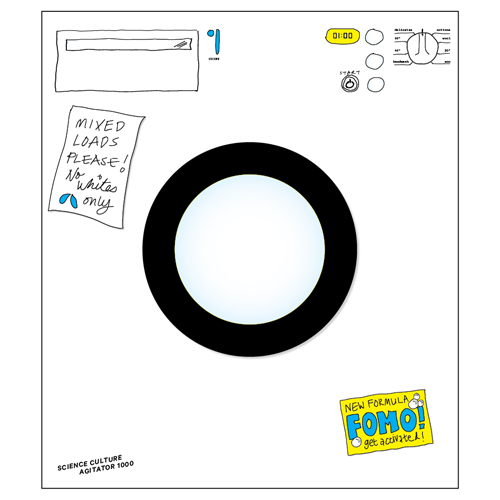
Here comes the ethics bit (concentrate!)
The following is an ethics statement. Basically, what you see is what you get – it is a way to collect participant views about science culture in an informal way, to 'air' feelings the conference might be bringing up. Secondly the format is part of a suite of design tools I am investigating for my PhD research (which is about using design as a way to help scientists think reflexively about their science communication).
Information will be collated for NZAS and my PhD. The documentation may include photographing and reproducing images of the installation and its content. Any contributions you make will remain unattributed unless you choose to add your name. There will be a time lapse film running to help me see how people engage with the format. I will give you the opportunity to give me your details so that I can follow up about your experiences, at which point the full information below becomes more pertinent. The ethics of this approach have been discussed with my supervisors and peers, and has gone through the university ethics process. If you have any questions, concerns or comments, please do speak to me or my supervisors.
Full information sheet for research participants
Researcher: Jo Bailey
Supervised by: Dr Rhian Salmon and Dr Rebecca Priestley
PROJECT (working title):
Engagement by Design, Engagement through Design
Designing approaches to foster reflexive science communication
You are invited to take part in this research. Please read this information before deciding whether or not to take part. If you decide to participate, thank you. If you decide not to participate, thank you for considering this request.
Who am I?
My name is Jo Bailey and I am a Doctoral student in the Science in Society group at Victoria University of Wellington. My research is funded by Te Pūnaha Matatini, a Centre of Research Excellence hosted by the University of Auckland. You can find out more about me here.
What is the aim of the project?
Ultimately, this research seeks to provide tools to enable best practice science communication in New Zealand. This will involve investigating how, why, where and to whom scientists currently communicate their research, how they identify audiences, how they assess the effectiveness of their communication, the challenges they face and the successes and failures they have experienced. It draws on design approaches to aid reflexivity about science and science communication. This research has been approved by the Victoria University of Wellington Human Ethics Committee [application number 025554].
How can you help?
You have been invited to participate because you are either a researcher (within Te Pūnaha Matatini or other institution), or have another pertinent perspective on the field of Science Communication, or are a participant at an event at which I am conducting research, or you have been active on social media discussing pertinent science communication topics. In this case, it is because you are attending NZAS 2019.
I would like permission to reproduce your contributions to the installation and any public social media posts, and, if you provide your contact details, to ask you further questions about your experience. In any follow up correspondence you can choose to not answer any question without giving a reason. You can revoke my permission to use the contents of our conversation within two months of it taking place. You can withdraw from the study by contacting me within two months of the interview. If you withdraw, the information you provided will be destroyed or returned to you.
What will happen to the information you give?
The information you provide will be used to inform the research direction. This may involve using some of your thoughts to produce ‘personas’ – hypothetical ‘users’ developed by identifying common themes, goals or behaviours across multiple participants that can then be used to make any suggested design outcomes user-centred. The information from my research will be used in my PhD thesis and in informing interim publications or conference presentations.
If you are a Te Pūnaha Matatini staff member, investigator or associated person, you may be identified as such but only after asking your permission to do this. If you work for another organisation your organisation may be named (provided you both agree, and have the authority to agree to this on behalf of the organisation). If either of these scenarios could identify you or if the content may be sensitive, you will be provided with a draft and asked to agree to your name or organisation being used. You will not be named in any outputs without you first seeing a draft and having the opportunity to request anonymisation. If I wish to quote you in a report or presentation you will be provided with a draft and asked to agree to your name being used.
If I conduct a follow up interview the interview will only be transcribed in full if there is a need to do so. Generally, the audio recordings will allow me to check notes made in the interviews. Only my supervisors and I will read the notes or have access to the audio recordings. If a transcript is required, a transcriber may be employed, and they will be required to sign a confidentiality agreement. The interview transcripts, summaries and any recordings will be kept securely and destroyed within five years of the project conclusion.
If you accept this invitation, what are your rights as a research participant?
If I approach you for follow up you do not have to accept this invitation if you don’t want to. If you do decide to participate, you have the right to:
- choose not to answer any question;
- ask for a recorder to be turned off at any time during the interview;
- withdraw from the study within two months of the interview;
- ask any questions about the study at any time;
- receive a copy of your interview recording;
- be able to read any reports of this research by emailing the researcher to request a copy.
If you have any questions or problems, who can you contact?
If you have any questions, either now or in the future, please feel free to contact either me or my supervisors:
Jo Bailey, Doctoral Student, jo.bailey@vuw.ac.nz
Dr Rhian Salmon / Dr Rebecca Priestley
Senior Lecturer / Associate Professor, Science in Society
04 4635507 / 04 4635233 ext 7134
rhian.salmon@vuw.ac.nz /rebecca.priestley@vuw.ac.nz
If you have any concerns about the ethical conduct of the research you may contact the Victoria University HEC Convenor: Associate Professor Susan Corbett. Email susan.corbett@vuw.ac.nz or telephone +64-4-463 5480.
